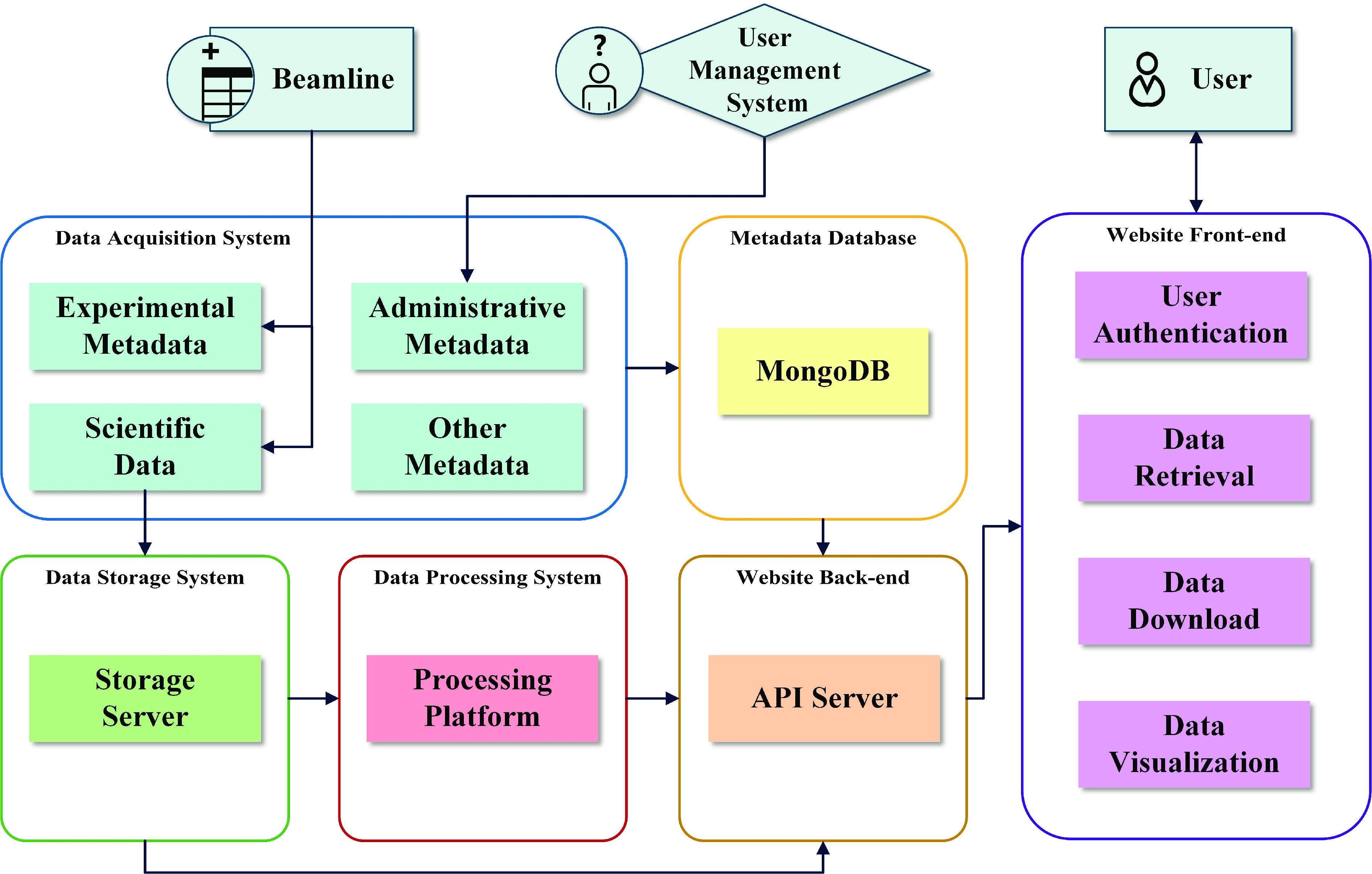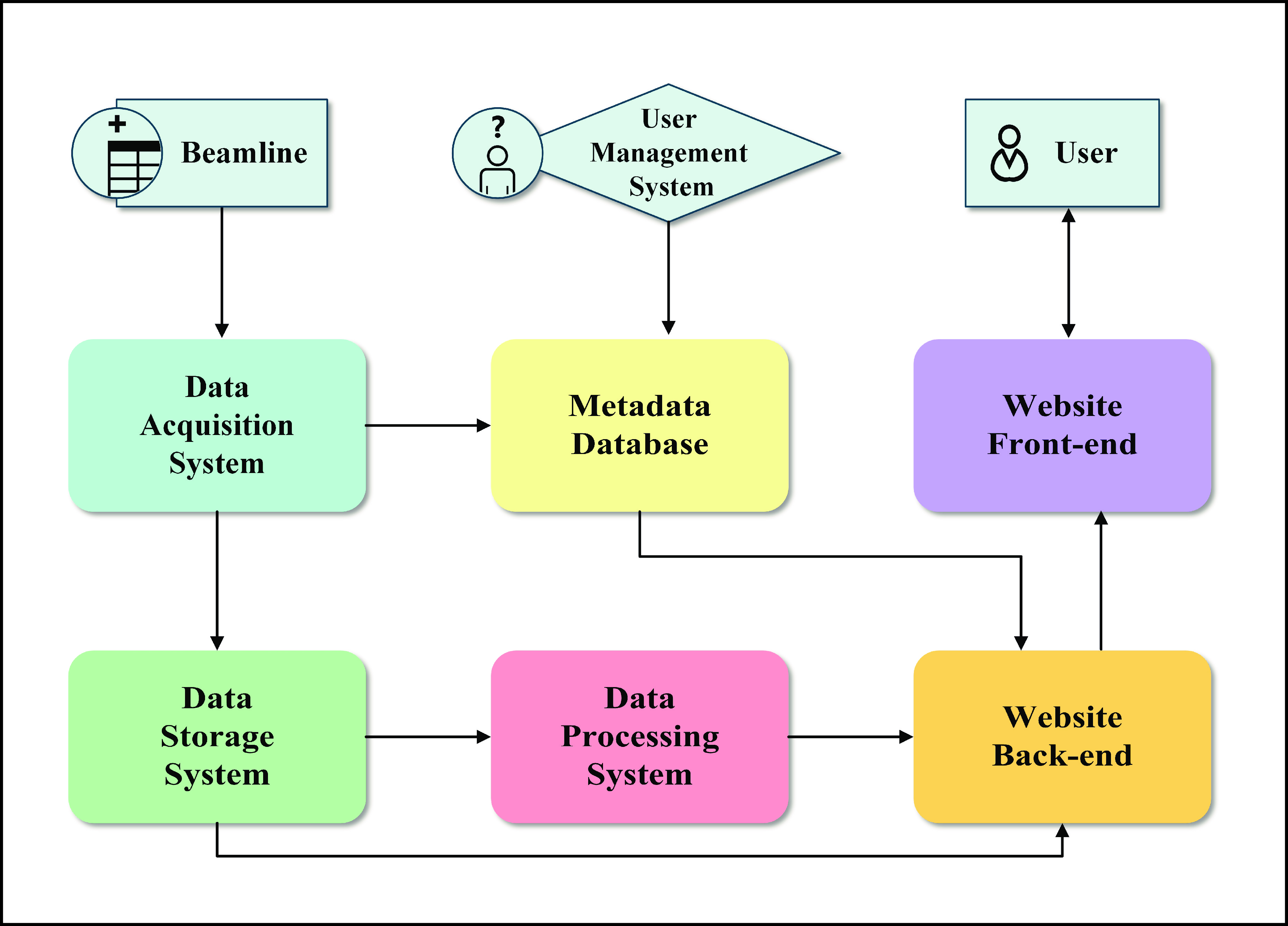
ISSN 0253-2778
CN 34-1054/N
Hefei Light Source (HLS) is a synchrotron radiation light source that primarily produces vacuum ultraviolet and soft X-rays. It currently consists of ten experimental stations, including a soft X-ray microscopy station. As part of its ongoing efforts to establish a centralized scientific data management platform, HLS is in the process of developing a test system that covers the entire lifecycle of scientific data, including data generation, acquisition, processing, analysis, and destruction. However, the instruments used in the soft X-ray microscopy experimental station rely on commercial proprietary software for data acquisition and processing. We developed a semi-automatic data acquisition program to facilitate the integration of soft X-ray microscopy stations into a centralized scientific data management platform. Additionally, we created an online data processing platform to assist users in analyzing their scientific data. The system we developed and deployed meets the design requirements, successfully integrating the soft X-ray microscopy station into the full lifecycle management of scientific data.

Flowchart of the scientific data management system.
| [1] |
Black A P, Sorrentino A, Fauth F, et al. Synchrotron radiation based operando characterization of battery materials. Chemical Science, 2023, 14: 1641–1665. DOI: 10.1039/D2SC04397A
|
| [2] |
Chen Y L, Wang Y C, Zhang Y, et al. Elastic-beam triboelectric nanogenerator for high-performance multifunctional applications: Sensitive scale, acceleration/force/vibration sensor, and intelligent keyboard. Advanced Energy Materials, 2018, 8: 1802159. DOI: 10.1002/aenm.201802159
|
| [3] |
Cao L N, Liu W, Luo Q Q, et al. Atomically dispersed iron hydroxide anchored on Pt for preferential oxidation of CO in H2. Nature, 2019, 565: 631–635. DOI: 10.1038/s41586-018-0869-5
|
| [4] |
Su H, Zhou W L, Zhou W, et al. In-situ spectroscopic observation of dynamic-coupling oxygen on atomically dispersed iridium electrocatalyst for acidic water oxidation. Nature Communications, 2021, 12: 6118. DOI: 10.1038/s41467-021-26416-3
|
| [5] |
Tan H, Tang B, Lu Y, et al. Engineering a local acid-like environment in alkaline medium for efficient hydrogen evolution reaction. Nature Communications, 2022, 13: 2024. DOI: 10.1038/s41467-022-29710-w
|
| [6] |
Liu J, Li F, Chen L, et al. Quantitative imaging of Candida utilis and its organelles by soft X-ray Nano-CT. Journal of Microscopy, 2018, 270 (1): 64–70. DOI: 10.1111/jmi.12650
|
| [7] |
Loconte V, Chen J H, Vanslembrouck B, et al. Soft X-ray tomograms provide a structural basis for whole-cell modeling. The FASEB Journal, 2023, 37: e22681. DOI: 10.1096/fj.202200253R
|
| [8] |
Bai H, Guan Y, Liu J, et al. Precise correlative method of Cryo-SXT and Cryo-FM for organelle identification. Journal of Synchrotron Radiation, 2020, 27: 176–184. DOI: 10.1107/S1600577519015194
|
| [9] |
Peng M W, Guan Y, Liu J H, et al. Quantitative three-dimensional nondestructive imaging of whole anaerobic ammonium-oxidizing bacteria. Journal of Synchrotron Radiation, 2020, 27: 753–761. DOI: 10.1107/S1600577520002349
|
| [10] |
Rees N, Corney D. Scientific data management at Diamond Light Source. Didcot, UK: Diamond Light Source, 2021 . https://www.slideserve.com/betsy/scientific-data-management-at-diamond-light-source. Accessed August 12, 2023.
|
| [11] |
Tian H L, Zhang J R, Yan L L, et al. Distributed data processing and analysis environment for neutron scattering experiments at CSNS. Nuclear Instruments and Methods in Physics Research Section A: Accelerators, Spectrometers, Detectors and Associated Equipment, 2016, 834: 24–29. DOI: 10.1016/j.nima.2016.07.043
|
| [12] |
The ICAT Collaboration. The ICAT project. 2021 . https://icatproject.org/. Accessed August 10, 2023.
|
| [13] |
Egli S. SciCat: PSI-ESS-MaxIV data catalogue. Villigen, Switzerland: Paul Scherrer Institute, 2018 . https://indico.esss.lu.se/event/1066/contributions/452/attachments/370/565/scicatLund.pdf. Accessed August 15, 2023.
|
| [14] |
Sjöblom P, Amjad A, Bell P J, et al. Stable operation of the MAX IV Laboratory synchrotron facility. Proceedings of the 17th International Conference on Accelerator and Large Experimental Physics Control Systems. New York: JACoW Publishing, 2020 : 530−535.
|
| [15] |
Wang C P, Yu F, Liu Y Y, et al. Deploying the Big Data Science Center at the Shanghai Synchrotron Radiation Facility: the first superfacility platform in China. Machine Learning: Science and Technology, 2021, 2: 035003. DOI: 10.1088/2632-2153/abe193
|
| [16] |
SciCat. SciCat project. 2021 . https://scicatproject.github.io/. Accessed August 16, 2023.
|
| [17] |
Lin G, Zhang D D, Zhang Z, et al. Development of experimental data management system for HLS-II based on SciCat. Nuclear Techniques, 2022, 45 (2): 020101. DOI: 10.11889/j.0253-3219.2022.hjs.45.020101
|
| [18] |
Habermann T, Folk M J. The Hierarchical Data Format (HDF): A foundation for sustainable data and software. In: Proceedings of the AGU Fall Meeting Abstracts. San Francisco, CA, USA: American Geophysical Union, 2014 : IN21D-07.
|
| [19] |
Willman J. Overview of PyQt5. In: Modern PyQt. Berkeley, CA, USA: Apress, 2021 : 1−42.
|
| [20] |
Chinese Academy of Sciences. Chinese Academy of Sciences Large Research Infrastructures User Service Platform. Beijing: Chinese Academy of Sciences, 2015 . https://lssf.cas.cn/. Accessed August 15, 2023.
|
| [21] |
Perkel J M. Why Jupyter is data scientists’ computational notebook of choice. Nature, 2018, 563: 145–146. DOI: 10.1038/d41586-018-07196-1
|
| [22] |
Quevedo S, Merchán F, Rivadeneira R, et al. Evaluating Apache OpenWhisk-FaaS. In: 2019 IEEE Fourth Ecuador Technical Chapters Meeting (ETCM). Guayaquil, Ecuador: IEEE, 2019 : 1–5.
|